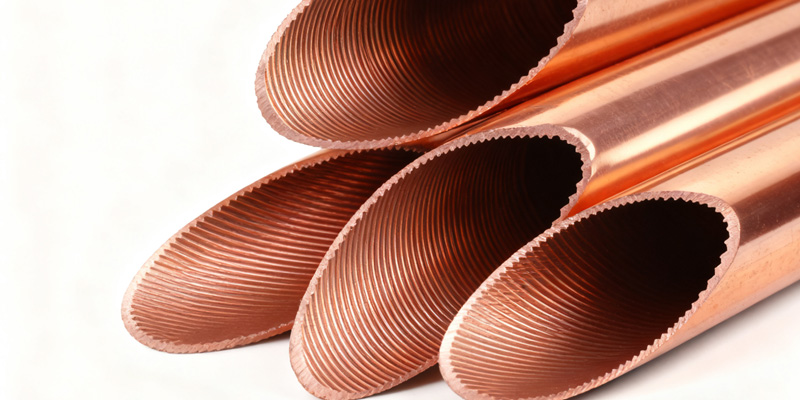In the cooling and air conditioning systems, the heating exchanger (condenser) determines the cooling performance of the entire machine. While there are many factors that influence heat exchange efficiency, the copper pipe structure is absolutely the most important procedure. With the continuous increase of high-efficiency standards (like ERP in the EU and AHRI in America), traditional smooth copper pipes are not sufficient to meet the high-efficiency demands from the air conditioning systems. In that case, the inner grooved copper pipe had been developed and quickly become the core material of the high-efficiency heating exchanger in the new generation.
I. What is the "Inner Grooved Copper Pipe"?
Inner grooved copper pipe is to add uniform spiral grooves on walls inside of the copper pipe, forming a structure similar to "micro-threads". This increases its contact area with the refrigerant, significantly changes the state of refrigerant flow, and improves the heating transfer coefficient in the process of evaporation and condensation.
Compared with traditional smooth copper pipe, it has the following features:
· Enlarged inside surface by 20%-60%;
· Increased fluid disturbance leads to increased turbulence;
· Promotes the formation of a uniform film of refrigerant on the inner wall;
· Reduce gas-liquid stratification and improve evaporation efficiency.

II. Analysis of heat transfer mechanisms
Its high heat exchange performance is conducted by the following three mechanisms:
Enhanced Turbulence Effect
The inner groove design forces the production of rotation and turbulence during the flow of refrigerant, which makes more fluid directly contact the inner piping wall, improving the working efficiency of the air conditioners.
Thin Film Evaporation Effect
The thickness of refrigerant liquid film determines the heat transfer resistance in the evaporator. Its spiral design could promote the liquid film with an average distribution between the grooves, which could reduce the dry spots and improve the evaporating uniformity.
Capillary Action and Liquid Redistribution
When the pipes are placed at an angle or vertically, the spiral grooves force the refrigerant liquid to flow upward with the help of capillary adhesion, avoiding a liquid accumulation at the bottom and increasing the entire heat transfer uniformity.
III. Improvement to the air conditioning system efficiency
Abundant research and experimentation show that:
· 30%-70% increase of the heat transfer coefficient on the evaporators and condensers;
· 15%-20% reduced heat exchange areas under the same exchange capacity;
· 5%-10% increased EER/COP of the whole unit;
· 10%-15% reduced charging weight of the refrigerant.
This means that, under the premise of meeting energy conservation regulations, enterprises could achieve miniaturized design, lightweight production and cost optimization
IV. Applications
Inner grooved copper pipes are widely used nowadays, particularly in wall mounted air conditioners, floor standing AC units, light commercial VRF systems, heat pump water heaters, air-sourced heating appliances, freezers, and so on. For those with high requirements of energy efficiency, inner grooved copper pipes are the basic options for the cooling systems, such as the R32 and R290 series products.
The appearance of the inner grooved copper pipe represents not only a structural innovation in cooling technology but also an absolute result for the upgrade of the energy conservation standards. For the air conditioners with high-efficiency pursuit, the inner grooved copper pipe had become an indispensable core material for their heating exchange design.